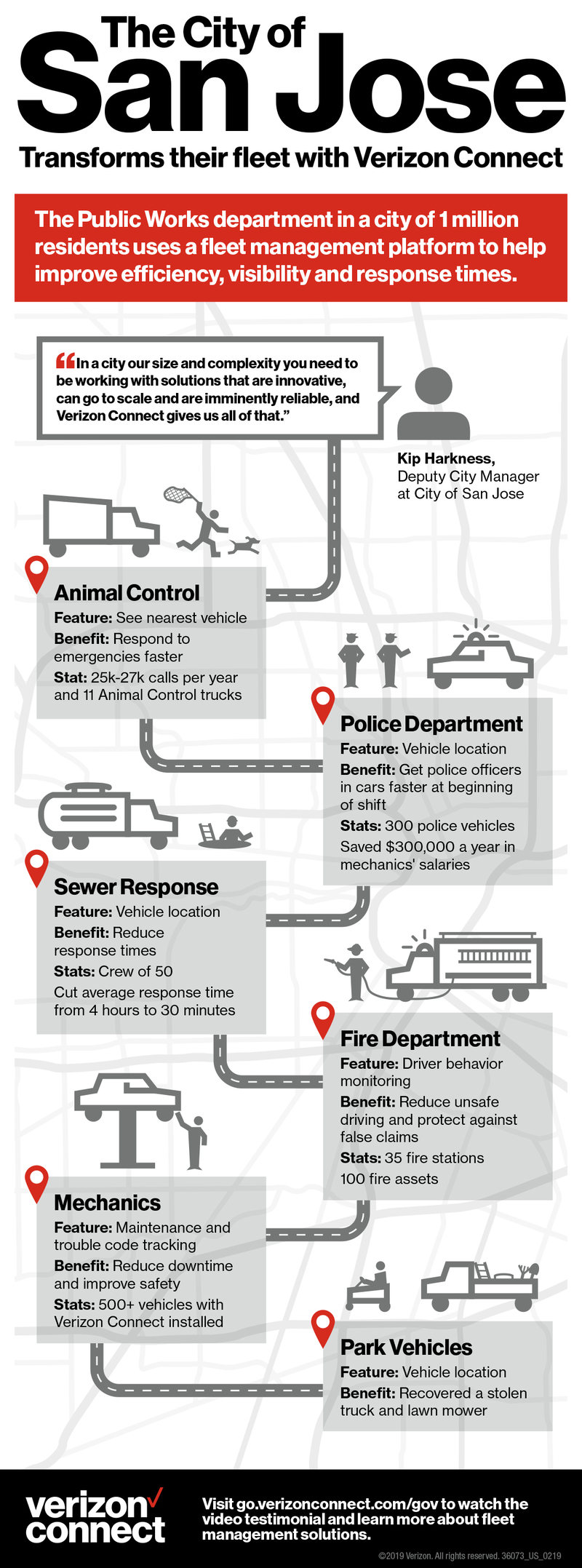Learn how to identify the right fleet management solution for your government fleet by downloading our Fleet Management and Asset Tracking Solution Buyer's Guide.
Government Fleets Transform with Data Insights
Fleet management for government organizations may seem like more of a “nice to have” than a “have to have,” but when your success is largely measured in subjective public approval rather than black-and-white profitability, access to objective data is essential.
Michael Lock, Vice President and Principal Analyst at the Aberdeen Group articulates the importance of using data for awareness and vigilance in the report Allocation and Optimization: ERP and BI Team Up in the Public Sector.
“While public sector organizations may not be subject to the same Wall Street scrutiny as a typical publicly traded corporation, the network of stakeholders involved either directly or indirectly is as varied as it is powerful. These organizations are charged with anything from the spending of our tax dollars to the upkeep of our public infrastructure, to the education of our children. As such, these decisions take on a different kind of importance.”
Whether it’s for analyzing the effectiveness of programs and activities or making data-driven decisions, access to performance metrics and the health and utilization of your fleet is key. In fact, in its report, Aberdeen Group reports of its respondents with an enterprise resource planning (ERP) platform in place:
- 64% say it provides them with a unified view of labor costs and workforce data (compared to 28% for those that don’t have an ERP)
- 57% say they have real-time collaboration across departments (compared to 22% for those that don’t have an ERP)
- 52% are able to adjust resource allocation to operational need (compared to 27% for those that don’t have an ERP)
Making the most of what you have
Demonstrating the responsible and sustainable use of public dollars is not simple or easy task. Accurate utilization reporting and the ability to make effective and quick decisions are important to keeping costs down and avoiding excessive spending.
Sorting through the data, however, can feel burdensome if insights are not easily discernible. Key metrics that can help government fleets measure and optimize utilization include:
- Miles traveled or hours of use: Provides a data-driven baseline to develop a utilization trend.1
- Custom threshold for low utilization: Establish your unique baseline to inform a threshold for low utilization to help you reallocate effectively.2
- Drive time/on-site time/idle time: Analyzing stops and jobs that are repeatedly longer than expected, slow routes and drivers whose work habits suddenly slow down.
According to custom research from Frost & Sullivan LCV Telematics Market, organizations using telematics were able to boost fleet utilization up to 12% with fleet management solutions.3
Keeping an eye on every dollar
Cost is of extra concern for government fleets, resulting from greater scrutiny and limited resources. For these reasons, monitoring activities and performance—anything that impacts your balance sheet— including some you might not expect, is the first step in getting your fleet costs in order.
- Limit unauthorized vehicle usage with geofences and automated alerts
- Monitor fuel consumption for wasteful behavior and fraud
- Address unsafe and fuel-wasting driving habits like hard stopping and idling
- Stay aware of vehicle maintenance and health to avoid unexpected downtime and repairs
- Use smart scheduling and payroll and digital record keeping to make the most of your workforce’s time
- Route optimization helps drivers avoid traffic delays and unnecessary miles.
Fleet life cycle management
Preparing for a digital future is as important for public fleets as any Fortune 500 company. Government fleets are very often fleets of large size and diversity, making the job of fleet management complex and time consuming. With training becoming ever-complex, technology becoming ever-pervasive, and transparency becoming more important, fleets must begin now to collect, interpret, and implement data in their everyday activities.
Government Fleet’s 2018 benchmarking report shows that advanced technology ranks second among respondents’ top concerns, and about three-quarters have implemented telematics in at least some of their vehicles. A centralized dashboard where key metrics could be viewed and tracked enabled respondents to improve utilization and greater overall productivity.
For example, staying on top of preventative maintenance is critical to lengthening the life of any vehicle. With vehicle age trending older in public fleets, according to this report, the ability to proactively schedule preventative maintenance will be key in making advances in reducing vehicle downtime.
San Jose transforms its fleet with data
Being located at a major center for technological innovation, the City of San Jose needed software that met a certain level of expectation when it comes to service. Deputy City Manager of the City of San Jose, Kip Harkness explains, “Our vision for the city is that we need to be as innovative as the community that we serve. We’re going to be needing to make decisions using data.”
They needed a platform that would improve planning and dispatching as well as visibility for a diverse fleet. It was also important that the system seamlessly integrated with existing systems to provide what Fleet Manager Dan Sunseri says is the complete picture. “We have that additional data that we can bring into our datasets already, take that information, report on it and get useful information to make key decisions about vehicle purchases…driver behavior […] idle reduction and fuel use, so the information is invaluable.”
From Animal Control to Police, to Sewer Response, to Fire and more, the City of San Jose was able to transform the way they worked to improve efficiency, visibility, and response times.
The key is intelligent data
Today’s technology savvy organizations have no shortage of data about every aspect of the workday, from vehicle diagnostics to location. The real difference maker is in the insight, the intelligence gathered from that data, and far too often, software that gathers this data does only that—gather the data. Then sorting through and making sense of mountains of numbers to decide next steps becomes an entirely new job on top of the job you already have.
The value, then, in a telematics system is in its ability to widen your visibility, deepen your knowledge, and sharpen your business without adding to your burden. With custom alerts and dashboards, a platform like those offered by Verizon Connect can take you from laggard to leader seamlessly.

Sources
1 “Utilization Studies Do More Than Right-Size Fleets.” Government Fleet. May 2015. http://www.government-fleet.com/article/story/2015/05/utilization-studies-do-more-thanright-size-fleets.aspx
2 “Utilization Studies Do More Than Right-Size Fleets.” Government Fleet. May 2015. www.government-fleet.com/article/story/2015/05/utilization-studies-do-more-than-rightsize-fleets.aspx
3 Custom Research from Frost & Sullivan LCV Telematics Market—November 2015. See 5 Steps to Improving Government Fleet Utilization
Find out how our platform gives you the visibility you need to get more done.




